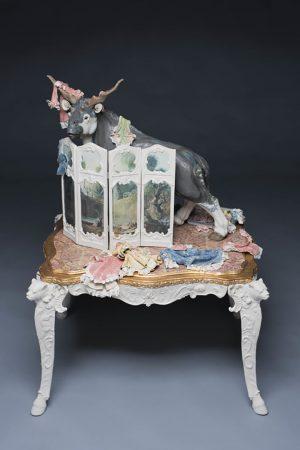Ariel Bowman creates elaborate worlds through her aesthetically unique ceramic pieces
AZUL SORDO
photo editor


mixed media, porcelain table from 2018.
A prehistoric species of aquatic sloth lounges in a luxurious 18th century Rococo style bathtub, overflowing with bubbles — a glimpse into the elaborate worlds constructed by NE ceramics instructor Ariel Bowman.
Fascinated by the parallels between art and science, Bowman works to unite these worlds through her detailed ceramic pieces.
Perhaps her most widely recognized body of work, “Wondrous Creatures,” places carefully selected prehistoric animals in picturesque Enlightenment era environments.
This juxtaposition mirrors “a time when our relationship to nature was being expanded by scientific discoveries, yet separated by the disappearance of wild places,” Bowman wrote in her art portfolio.
As a child, Bowman spent her time flipping through animal encyclopedias and working in the ceramics studio with her mother, NE ceramics professor Karmien Bowman. Her father specializes in restoring 18th century Rococo furniture, a style that heavily influences much of her work.
Having always been drawn to the stranger and lesser known creatures, her artistic focus on prehistoric animals goes beyond aesthetics.
“I definitely try to find the weirdest ones possible,” Bowman said. “People get so excited and interested when they find out that they really existed, that there are fossils of that strange thing — I love that.”
 In her piece “Haute Couture” a prehistoric giraffe wanders behind a folding screen, intricately decorated gowns draped over it’s antlers. The screen, a sprawling landscape painted on its panels, symbolizes transformation through natural selection, Bowman said.
In her piece “Haute Couture” a prehistoric giraffe wanders behind a folding screen, intricately decorated gowns draped over it’s antlers. The screen, a sprawling landscape painted on its panels, symbolizes transformation through natural selection, Bowman said.
“It’s worlds within worlds and you keep questioning your understanding of the piece,” Bowman said. “That constant questioning that I feel is very indicative of scientific people and artistic people. We’re always questioning everything.”
This body of work can still be viewed at Florida Museum of Natural History’s virtual exhibit. After organizing a temporary exhibit June 2018, project manager Dale Johnson said he wanted the experience to live on through their website.
“I am awed by the fine detail in her ceramics — the most delicate lace and folds
of fabric, furnishings and glazes all executed perfectly,” Johnson said. “This uncommon combination of knowledge and skills allows her to engage with people at many levels.”
Before the pandemic, Bowman held ceramics workshops alongside her mother in their shared studio in Flower Mound, TX. Bowman now holds workshops exclusively online, opening her doors to students across the globe.
Professional sculptor Diane Cardill, based in Montreal, Canada, was grateful for the opportunity to work with Ariel Bowman despite the 1,746 miles between them.
“After taking my first workshop I was hooked,” Cardill said. “Technology has brought our studios tog e the online efforts continue.”

Ceramic,” a mixed media project from 2019.

